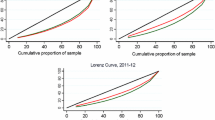Abstract
Zambia, like many other African countries is undergoing rapid urbanization and rising per capita income, accompanied by rising population. This study sought to understand the changing food expenditure patterns in Zambia and the implications of this transformation on food policy, food market development, and rural development. The main source of data for the study was the Living Conditions Monitoring Survey (LCMS) data collected in 1996, 1998, 2010, and 2015 by the Central Statistical Office (CSO) of Zambia. Trends in expenditure shares were done for each of the food categories over time and by rural and urban areas. The study found that there have been major declines in the shares of food expenditure on maize among rural and urban households between 1996 and 2015. However, wheat shares in urban households’ diets increased while rural households experienced a drop in coarse grains and tubers. Wealthier households spent larger shares of their food expenditure on wheat, rice and potatoes. Further, wealthier households increased their share of expenditure on animal protein, while poorer households doubled their expenditure on vegetables. Thus, transformation of food expenditure patterns is evident mostly among the high income households, mainly in urban areas. Overall the changing pattern of food expenditure is consistent with rising incomes and rapid urbanization. However, the disparities between the different income groups and between rural and urban areas are indicative of a rise in income inequality both in urban and rural parts of Zambia.









Similar content being viewed by others
Notes
This a traditional beverage made from maize
The Gini Coefficient helps our understanding of the equality of income distribution in the population. This measures household income distribution using an index of inequality, which ranges from 0 to 1. A coefficient of 0 represents total equality in income distribution, while a coefficient of 1 represents total inequality (CSO 2012).
References
Chauvin, N. D., Mulangu, F., & Porto, G. (2012). Food Production and Consumption Trends in Sub-Saharan Africa: Prospects for the Transformation of the Agricultural Sector, UNDP Africa Policy Notes No. 2012–011. New York: United Nations Development Programme Regional Bureau for Africa.
Cirera, X., & Masset, E. (2010). Income Distribution Trends and Future Food Demand. Philosophical Transactions of the Royal Society of London B: Biological Sciences, 365(1554), 2821–2834.
CSO. (1998). Living conditions monitoring survey. Lusaka: CSO.
CSO. (2005). Living conditions monitoring survey report for 2004. Lusaka: CSO.
CSO. (2010). Living conditions monitoring survey. Lusaka: CSO.
CSO. (2012). Living conditions monitoring survey report for 2006 and 2010. Lusaka: CSO.
CSO. (2016). Living conditions monitoring survey report for 2015. Lusaka: CSO.
CSO. (2017). District retail prices. Lusaka: CSO.
CSO (Central Statistical Office). (1996). Living conditions monitoring survey (LCMS)report for 1996. Lusaka: CSO.
Das Nair, R., & Chisoro, S. (2015). The Expansion of Regional Supermarket Chains: Changing Models of Retailing and the Implications for Local Supplier Capabilities in South Africa, Botswana, Zambia, and Zimbabwe, WIDER Working Paper No. 2015/114. Helsinki: UNU-WIDER.
Gale, H. F., & Huang, K. (2007). Demand for Food Quantity and Quality in China, United States Department of Agriculture Economic Research Service Report No. 32. Washington, DC: United States Department of Agriculture Economic Research Service.
Hansen, A. (2018). Consuming Development: Capitalism, Economic Growth and everyday Life. Development Economics. Accessed online 6 January 2018 at https://developingeconomics.org/2018/01/11/consuming-development-capitalism-economic-growth-and-everyday-life/
Hassen, I. W., Dereje, M., Minten, B., & Hirvonen, K. (2016). Diet Transformation in Africa: The Case of Ethiopia, ESSP Working Paper No. 87. Addis Ababa: International Food Policy Research Institute and Ethiopian Development Research Institute.
Hichaambwa, M., Beaver, M., Chapoto, A., & Weber, M. T. (2009). Patterns of Urban Food Consumption and Expenditure in Zambia: An Overview Report, Based on the CSO/MACO/FSRP Food Consumption Survey in Urban Areas of Lusaka, Kitwe, Mansa, and Kasama, 2007–2008. Lusaka: CSO/MACO/FSRP.
Sichilimo, M. (2016). JCTR Encourages Consumption of Local Rice. Lusaka, Zambia: Jesuit Centre for Theological Reflection. Accessed online 27 July, 2016 at http://www.jctr.org.zm/images/stories/food/Rice_advetorial.pdf.
Tschirley, D., Haggblade, S., & Reardon, T. (Eds.). (2013). Africa’s Emerging Food System Transformation. East Lansing: Michigan State University Global Center for Food System Innovation.
United Nations. (2014). World Urbanization Prospects: The 2014 Revision. New York: The United Nations Department of Economic and Social Affairs, Population Division. Can be accessed on line at https://esa.un.org/unpd/wup/.
Wilde, P. (1989). Changing Food Consumption Patterns in Sub-Saharan Africa. Washington, DC: USAIDFVA/PPM.
World Bank. (2014). GDP Per Capita Indicator. Washington, DC: World Bank.
World Health Organization (WHO). (2018). Double burden of malnutrition. Accessed online 6 January, 2018 at http://www.who.int/nutrition/double-burden-malnutrition/en/
Funding
We wish to acknowledge the financial and substantive support of the Swedish International Development Agency (SIDA) and the United States Agency for International Development (USAID) in Lusaka.
Author information
Authors and Affiliations
Corresponding author
Ethics declarations
Statement on conflict of interest
We as authors hereby declare that there is no conflict of interest arising from the publication of this article in Food Security.
Details of ethical approval
The analysis done for this article used datasets collected by the Government of the Republic of Zambia through the Central Statistical Office (CSO), which is the department charged with national statistics. The CSO complied with ethical standards during the collection of data.
Statement of informed consent
As part of standard practice by the CSO, respondents were given full information on the survey prior to the commencement of the questionnaire based interviews. Further, respondents were also given an option to discontinue the interview.
Appendix
Appendix
Rights and permissions
About this article
Cite this article
Chisanga, B., Zulu-Mbata, O. The changing food expenditure patterns and trends in Zambia: implications for agricultural policies. Food Sec. 10, 721–740 (2018). https://doi.org/10.1007/s12571-018-0810-7
Received:
Accepted:
Published:
Issue Date:
DOI: https://doi.org/10.1007/s12571-018-0810-7






